
The fungal order Agaricales, also known as gilled mushrooms or euagarics, contains some of the most familiar types of mushrooms. The order has 33 extant families, 413 genera, and over 13,000 described species, along with six extinct genera known only from the fossil record. They range from the ubiquitous common mushroom to the deadly destroying angel and the hallucinogenic fly agaric to the bioluminescent jack-o-lantern mushroom.

Agaricus is a genus of mushrooms containing both edible and poisonous species, with possibly over 300 members worldwide. The genus includes the common ("button") mushroom and the field mushroom, the dominant cultivated mushrooms of the West.

Camarophyllopsis is a genus of agarics in the family Clavariaceae. Basidiocarps are dull-coloured and have dry caps, rather distant, decurrent lamellae, white spores, and smooth, ringless stems. In Europe species are characteristic of old, unimproved grasslands which are a declining habitat, making them of conservation concern.
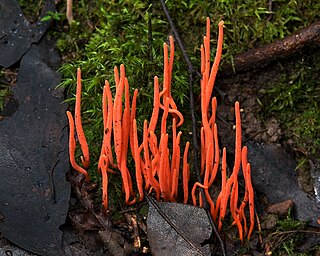
The Clavariaceae are a family of fungi in the order Agaricales. Collectively, they are commonly known as coral fungi due to their resemblance to aquatic coral, although other vernacular names including antler fungi, finger fungi, worm mold, and spaghetti mushroom are sometimes used for similar reasons.
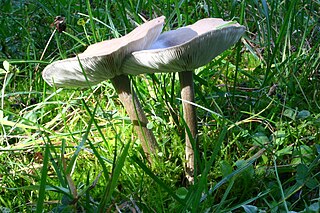
Melanoleuca is a poorly known genus of saprotrophic mushrooms traditionally classified in the family Tricholomataceae. Most are small to medium sized, white, brown, ocher or gray with a cylindrical to subcylindrical stipe and white to pale yellowish gills. The basidiospores are ellipsoid and ornamented with amyloid warts. Melanoleuca is considered a difficult group to study due to their macroscopic similarities among species and the need of a thorough microscopic analysis to separate species. DNA studies have determined that this genus is closely related to Amanita and Pluteus and that it does not belong to the family Tricholomataceae.
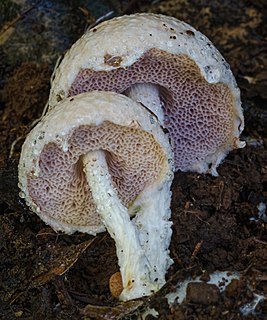
Austroboletus is a genus of fungi in the family Boletaceae. The widely distributed genus contains 28 species that form mycorrhizal relationships with plants.

Rhodocollybia is a genus of Basidiomycete mushroom. Species in this genus, formerly classified as a subgenus in Collybia, have fairly large caps, and have a pinkish-tinted spore print. Microscopically, they are characterized by having spores and basidia that are dextrinoid—staining deep reddish to reddish-brown with Melzer's reagent when tested for amyloidity. Rhodocollybia species are commonly found in temperate North America and Europe, and infrequently in Central and South America.

Hygrophoropsis is a genus of gilled fungi in the family Hygrophoropsidaceae. It was circumscribed in 1888 to contain the type species, H. aurantiaca, a widespread fungus that, based on its appearance, has been affiliated with Cantharellus, Clitocybe, and Paxillus. Modern molecular phylogenetic analysis shows that the genus belongs to the suborder Coniophorineae of the order Boletales.

Cystodermella is a genus of fungi in the family Agaricaceae. The genus comprises about 12 species, noted for producing agaric fruit bodies, bearing a cap, white gills and stipe with a fine, ephemeral ring. The genus was devised by Harri Harmaja in 2002, dividing the older genus Cystoderma into three independent genera: Cystoderma, Ripartitella and Cystodermella largely on the basis of microscopic differences. Cystodermella species bear non-amyloid spores and sometimes cystidia. The spores, in contrast to Ripartitella are not echinulate.

Cystolepiota is a genus of mushroom-forming fungi in the family Agaricaceae.

Micropsalliota is a genus of small agaric fungi in the family Agaricaceae. The genus contains about 60 species, most of which are found in tropical areas.

Infundibulicybe is a genus of fungi that is robustly placed incertae sedis as sister group to the Tricholomatoid clade. It has previously been part of the family of Tricholomataceae, but recent molecular phylogeny has shown it to take an isolated position within the Agaricales.

Pseudoomphalina is a genus of fungi in the placed in the family Tricholomataceae for convenience. The genus contains six species that are widespread in northern temperate areas. Pseudoomphalina was circumscribed by Rolf Singer in 1956. Pseudoomphalina was found to be paraphyletic to Neohygrophorus in a molecular phylogenetics study and since Pseudoomphalina is an older name, Neohygrophyorus was synonymized with it. The type species of Neohygrophorus was Neohygrophorus angelesianus, now Pseudoomphalina angelesiana. In earlier classifications based on anatomy prior to DNA sequence-based classifications, its unusual combination of features led taxonomists to independently create two subgenera in two genera: Hygrophorus subg. Pseudohygrophorus and Clitocybe subg. Mutabiles; the latter based on Neohygrophorus angelesianus but described under a new species name which is now placed in synonymy, Clitocybe mutabilis. All species of Pseudoomphalina are united by the presence of clamp-connections in their hyphae, an interwoven gill trama and amyloid spores. Pseudoomphalina angelesiana possesses grey-violaceous pigments that turn red in alkali solutions and lacks filiform, hyphal sterile elements in its hymenium and stipitipellis. These were features used to distinguish it from Pseudoomphalina as a genus, but Pseudoomphalina umbrinopurpurascens possesses these same pigments and the filiform elements of Pseudoomphalina. Molecular phylogenetics studies have also found some former species of Pseudoomphalina to belong in other genera. Pseudoomphalina pachyphylla was moved to its own genus, Pseudolaccaria, and Pseudoomphalina clusiliformis was synonymized with it. Pseudoomphalina flavoaurantia and Pseudoomphalina lignicola were found to belong in Clitocybula. Phylogenetically, Pseudoomphalina is in a tricholomatoid clade but not in the Tricholomataceae.
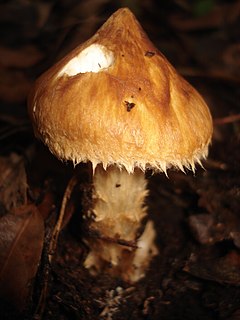
Squamanita is a parasitic genus of agaric fungi formerly classified in the family Tricholomataceae and is now in the Cystodermateae in the Squamanitaceae. The fruitbodies of this genus resemble a normal agaric but they emerge from parasitized fruitbodies of other agarics that Squamanita has deformed. The deformation may be massive and the host may then resemble a lump, or the deformation may be so subtle that the Squamanita appears to be grafted onto the stipe of the host that nearly always fails to form a pileus. Because of the seamless graft-like attachment or the severe deformation of the host into a nonrecognizable blob, early descriptions included features of the host in descriptions of Squamanita as if they were parts of the parasite. This error led to the creation of a separate subgenus because of misinterpretation of host veil tissue as part of the parasite and ultimately a separate genus, Dissoderma. Serendipitous discovery of one parasitized host fruitbody (Galerina) that formed its own pileus that then bore three Squamanita contortipes fruitbodies revealed the parasitic nature of the relationship for that species and the entire genus. This discovery was so shocking that it was featured in Nature magazine under the title 'Mycological mystery tour'. Once the parasitic nature was revealed, the term 'protocarpic tuber' used by earlier authors for the parasitized host base was replaced by the term 'cecidiocarp'.
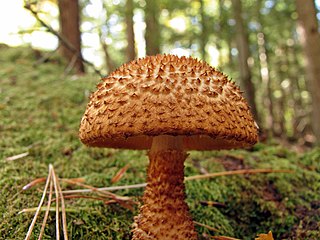
Leucopholiota decorosa is a species of fungus in the mushroom family Tricholomataceae. Commonly known as the decorated pholiota, it is distinguished by its fruit body which is covered with pointed brown, curved scales on the cap and stem, and by its white gills. Found in the eastern United States, France, and Pakistan, it is saprobic, growing on the decaying wood of hardwood trees. L. decorosa was first described by American mycologist Charles Horton Peck as Agaricus decorosus in 1873, and the species has been transferred to several genera in its history, including Tricholoma, Tricholomopsis, Armillaria, and Floccularia. Three American mycologists considered the species unique enough to warrant its own genus, and transferred it into the new genus Leucopholiota in a 1996 publication. Lookalike species with similar colors and scaly fruit bodies include Pholiota squarrosoides, Phaeomarasmius erinaceellus, and Leucopholiota lignicola. L. decorosa is considered an edible mushroom.

Panellus is a genus of more than 50 mushroom species of fungi in the family Mycenaceae as defined molecularly. Prior to molecular analyses the generic name had been used for any white-spored pleurotoid with amyloid spores. Unrelated but similar species are now classified in Sarcomyxa and Scytinotus. In older guides and other literature the type species had been placed in either Pleurotus or Panus and the poroid species had been classified in the synonymous genus Dictyopanus or in broadly defined genera like Polyporus (Polyporaceae) or the more closely allied Favolaschia (Mycenaceae). The closest molecular allies are Resinomycena and Cruentomycena.

Cystodermella cinnabarina is a basidiomycete fungus of the genus Cystodermella. Its fruiting body is a small agaric bearing a distinctive reddish-coloured grainy cap. It occurs in coniferous and deciduous forests throughout the world. Prior to 2002, this species belonged to genus Cystoderma, subsection Cinnabarina, under the name Cystoderma cinnabarinum which is still sometimes applied. Another often used synonym is Cystoderma terreyi.
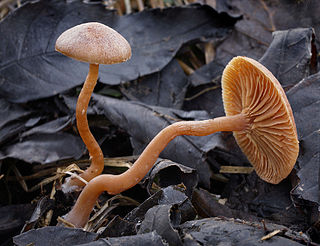
Tubaria is a genus of fungi in the family Tubariaceae. The genus is widely distributed, especially in temperate regions. Tubaria was originally named as a subgenus of Agaricus by Worthington George Smith in 1870. Claude Casimir Gillet promoted it to generic status in 1876. The mushrooms produced by species in this genus are small- to medium-sized with caps ranging in color from pale pinkish-brown to reddish-brown, and often with remnants of the partial veil adhering to the margin. Mushrooms fruit on rotting wood, or, less frequently, in the soil. There are no species in the genus that are recommended for consumption.


















